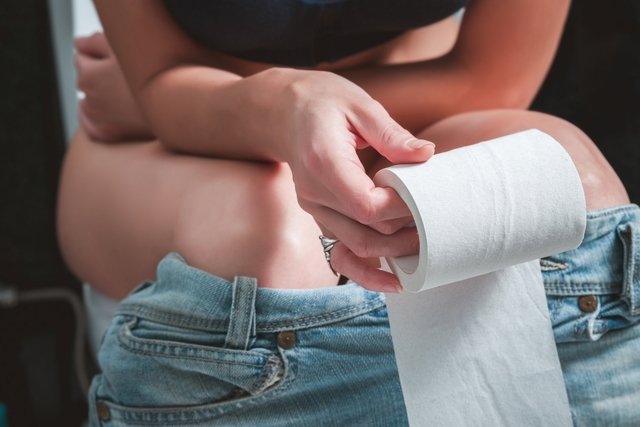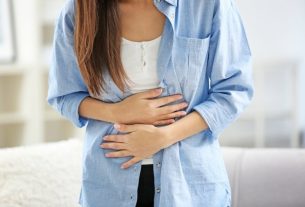Infectious diarrhea is caused by infection, mainly by viruses, bacteria or parasites. Fever, in addition to other symptoms such as vomiting, abdominal pain and the presence of blood in the stool may be present.
Ideally, the cause of infectious diarrhea should be identified to better guide treatment and prevent complications from arising. Therefore, whenever infectious diarrhea is suspected, it is important to consult a general practitioner, in the case of adults, or a pediatrician, in the case of children.
It is not recommended to use medicines that “hold” the intestine, because this way the infectious agent is not eliminated and there is a greater chance of complications. It is recommended to drink plenty of fluids, to avoid dehydration, and to have a light and healthy diet, to promote the elimination of the responsible microorganism.
Main causes
The main causes of infectious diarrhea are:
1. Viruses
Virus infection, such as rotavirus or norovirus, is the main cause of infectious diarrhea, being easily transmitted from one child to another and the main route of transmission is fecal-oral. Know how to recognize rotavirus infection. Know how to recognize rotavirus infection.
Symptoms: diarrhea is quite intense and has a strong odor. In addition, other symptoms may appear, such as fever and vomiting, for example.
What to do: In the case of suspected rotavirus infection, the ideal is to take the child to the pediatrician so that they can be examined and treatment can be indicated according to the symptoms presented. It is also important to offer water and natural juices to avoid dehydration, as well as a light diet to help the child recover faster.
2. Salmonella sp.
The infection by Salmonella sp. It happens through the ingestion of foods contaminated by this bacteria, mainly eggs, mayonnaise and raw chicken meat, for example.
Symptoms: severe diarrhea, vomiting and high fever. Symptoms of salmonellosis can appear up to 10 days after contact with the bacteria depending on the level of contamination of the food. See more about salmonellosis.
What to do: It is important to drink plenty of fluids and eat lightly. Furthermore, it is recommended to go to the doctor so that a laboratory diagnosis of salmonellosis can be made and antibiotic treatment can be started, if necessary.
3. Shigella sp.
Infectious diarrhea caused by Shigella sp. It also happens due to the consumption of food and water contaminated by the bacteria.
Symptoms: There may be pain in the stomach, nausea, vomiting and headache, in addition to diarrhea. The symptoms of shigellosis disappear after 5 to 7 days, however, if the symptoms persist or worsen, it is recommended to see a doctor for diagnosis and treatment.
What to do: In the case of shigellosis, the doctor usually recommends, in addition to resting and drinking plenty of fluids during the day, the use of antibiotics, such as Azithromycin, for example, to eliminate the bacteria from the body more quickly. The use of antibiotics, however, is only recommended when there is no improvement in symptoms and diarrhea lasts more than 7 days.
4. Escherichia coli
A E. coli is a bacteria naturally present in the human intestine, however, it can also be related to cases of diarrhea. This is because there are types of bacteria that can contaminate food and the toxin produced by this type of germ can trigger diarrhea.
Symptoms: There is usually abdominal pain, low fever and the presence of blood in the stool.
What to do: It is important that infection by Escherichia coli be identified through fecal examination, so that the sensitivity profile of this bacteria is known and the best antibiotic can be indicated. Furthermore, it is important that the person rests, drinks plenty of fluids and eats a light, balanced diet. Find out everything about Escherichia coli.
5. Giardia lamblia
A Giardia lamblia is an intestinal parasite responsible for causing diarrhea in children and occurs due to the consumption of cysts of this parasite present in contaminated water and food.
Symptoms: Giardiasis can be perceived through symptoms such as diarrhea, nausea, yellowish stools and abdominal pain, for example. Learn about other symptoms of giardiasis.
What to do: if infection by Giardia lamblia, it is important that the child goes to the pediatrician for tests to be carried out, especially fecal parasitology, so that the presence of cysts in the child’s feces can be identified. If the diagnosis is confirmed, the doctor may recommend the use of antiparasitic drugs, such as Metronidazole and Secnidazole, for example, in addition to recommending rest and drinking plenty of fluids.
6. Ascaris lumbricoides
O Ascaris lumbricoides, popularly called roundworm, is also a parasite that develops in the intestine and is transmitted through the consumption of contaminated food and water. For this reason, food must always be very well sanitized before being prepared and cooked.
Symptoms: can cause diarrhea, abdominal discomfort and vomiting.
What to do: treatment for infection by Ascaris lumbricoides involves the use of antiparasitics, such as Albendazole, Ivermectin or Mebendazole, which must be done according to the doctor’s instructions and aims to promote the elimination of this parasite. Learn more about treatment for Ascaris lumbricoides.
7. Entamoeba histolytica
A Entamoeba histolytica is the parasite responsible for amoebiasis, which is an infectious disease most common in children who live in regions with a tropical climate and poor basic sanitation conditions. See more about amoebiasis.
Symptoms: strong diarrhea, fever, bloody stools, nausea and tiredness may appear, for example.
What to do: It is important that infection by Entamoeba histolytica be identified and treated quickly to prevent complications from occurring. Therefore, as soon as the first symptoms of infectious diarrhea appear, it is recommended that the child undergo a stool test so that the diagnosis can be made and treatment can be started, which is normally done with Metronidazole for around 10 days or according to the doctor’s guidance.

Sign up for our newsletter and stay up to date with exclusive news
that can transform your routine!
Warning: Undefined array key "title" in /home/storelat/public_html/wp-content/plugins/link-whisper-premium/templates/frontend/related-posts.php on line 12
Warning: Undefined array key "title_tag" in /home/storelat/public_html/wp-content/plugins/link-whisper-premium/templates/frontend/related-posts.php on line 13




